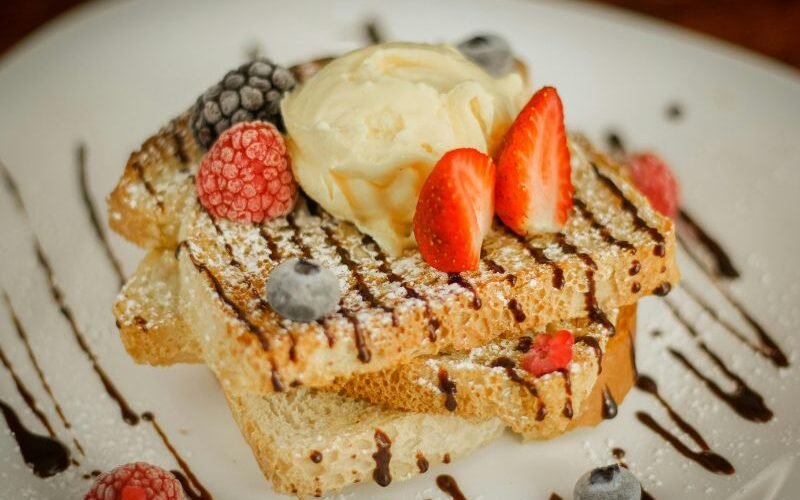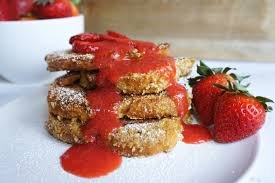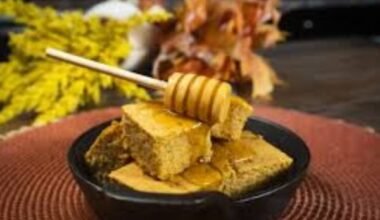The golden and crispy French toast has always been my go-to order for every breakfast. The generous pour of maple syrup makes it even more irresistible as the day goes by. There’s something downright enchanting about transforming basic bread and eggs into a morning masterpiece that feels like a warm embrace on a plate.
This irresistible craving drove me to search for more appealing ways to satisfy myself with new spices, ideas, and recipes. I found out that French toast with a generous sprinkle of eggs is a pure delight for breakfast and for keeping guess longer than they intended. i will guide you through this timeless dish with a few tricks I learned during my research and as I practiced through the kitchen. I am certain your mornings are about to become absolutely delicious!
Why French Toast With Eggs Is a Breakfast Favorite
French toast, also known as “eggy bread,” is a versatile dish that can be customized with various toppings like maple syrup, fresh fruits, whipped cream, or powdered sugar. The key to making the best French toast lies in the egg mixture, which gives it a rich, custard-like texture when cooked properly.
Key Benefits of French Toast With Eggs
- Quick and Easy: Ready in under 15 minutes.
- Budget-Friendly: It uses basic pantry ingredients.
- Customizable: It can be made sweet or savory.
- Kid-Friendly: A great way to get kids to eat eggs.

The Science Behind Perfect French Toast
Why Eggs Are Essential
Eggs act as a binding agent, creating a custard-like coating that caramelizes when cooked. The proteins in eggs coagulate at around 145°F (63°C), giving French toast its structure, while the fats contribute richness.
The Role of Milk
Milk (or cream) adds moisture and helps distribute heat evenly. Whole milk or half-and-half yields a creamier texture, while plant-based milks (almond, oat) work well for dietary restrictions.
Sugar & Cinnamon’s Impact
- Sugar promotes Maillard browning, enhancing flavor.
- Cinnamon adds warmth but can burn if cooked too long—add it to the egg mix rather than sprinkling it directly on the pan.
Ingredients for French Toast With Egg
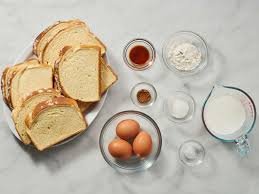
To make French toast with eggs, you’ll need the following ingredients:
- 4 slices of bread (thick-cut brioche, challah, or French bread work best)
- 2 large eggs (the star ingredient for binding and richness)
- ½ cup milk (whole milk, almond milk, or oat milk for a dairy-free option)
- 1 teaspoon vanilla extract (for enhanced flavor)
- ½ teaspoon ground cinnamon (adds warmth and aroma)
- 1 tablespoon granulated sugar (optional for sweetness)
- A pinch of salt balances the flavors.
- 2 tablespoons unsalted butter (for frying)
- Toppings of choice (maple syrup, berries, powdered sugar, or Nutella)
Step-by-Step Instructions for Making French Toast With Eggs
Step 1: Prepare the Egg Mixture
In a shallow bowl or baking dish, whisk together the eggs, milk, vanilla extract, cinnamon, sugar, and salt until fully combined. The mixture should be smooth and slightly frothy for an even coating.
Step 2: Soak the Bread Slices
Dip each slice of bread into the egg mixture, allowing it to soak for about 10-15 seconds per side. Avoid over-soaking, as this can make the bread soggy. Thicker bread slices can handle a bit more soaking without falling apart.
Step 3: Heat the Pan
Place a non-stick skillet or griddle over medium heat and melt a tablespoon of butter. Ensure the pan is hot but not smoking to prevent burning.
Step 4: Cook the French Toast
Once the butter is melted and slightly bubbly, add the soaked bread slices. Cook for 2-3 minutes per side or until golden brown and crispy. Flip carefully, using a spatula to avoid breaking the toast.
Step 5: Serve Warm
Transfer the cooked French toast to a plate and serve immediately with your favorite toppings. Popular choices include:
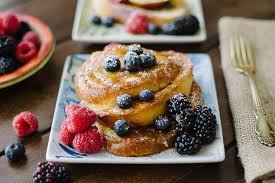
- Maple syrup and butter
- Fresh berries and whipped cream
- Honey and sliced bananas
- Nutella and chopped nuts
Choosing the Right Bread
Best Breads for French Toast
| Bread Type | Why It Works |
|---|---|
| Brioche | Rich, buttery, and soft with a tight crumb |
| Challah | Slightly sweet and sturdy enough to soak well |
| French Baguette | It has a crispy exterior and a chewy interior |
| Sourdough | Tangy flavor, holds shape well |
| Texas Toast | Extra thick, ideal for stuffed French toast |
Using Stale vs. Fresh Bread
- Stale bread absorbs the egg mixture without disintegrating.
- Fresh bread can work if it is lightly toasted first to remove excess moisture.
Tips for the Best French Toast With Eggs
To ensure your French toast turns out perfectly every time, follow these expert tips:
- Use Stale Bread: Slightly dry bread absorbs the egg mixture better without becoming mushy.
- Control the Heat: Cooking on medium heat ensures even browning without burning.
- Don’t Overcrowd the Pan: Cook in batches to maintain consistent heat distribution.
- Keep It Warm: Place cooked French toast in a 200°F (93°C) oven to keep it warm while preparing the rest.
- Experiment with Flavors: Add nutmeg, orange zest, or almond extract for extra depth.
Variations of French Toast With Egg
French toast is highly adaptable. Here are some delicious variations:
1. Stuffed French Toast
- Spread cream cheese or peanut butter between two slices before dipping in the egg mixture.
- Top with jam or fresh fruit compote.
2. Savory French Toast
- Skip the sugar and cinnamon.
- Add grated cheese, herbs, and black pepper to the egg mixture.
- Serve with avocado or fried eggs.
3. Vegan French Toast
- Replace eggs with mashed bananas or flaxseed gel.
- Use plant-based milk and coconut oil for frying.
4. Baked French Toast Casserole
- Layer soaked bread in a baking dish.
- Bake at 375°F (190°C) for 25-30 minutes for a hands-off version.
Frequently Asked Questions (FAQs)
1. Can I Make French Toast Without Eggs?
Yes! Substitute eggs with mashed bananas, yogurt, or a flaxseed-water mixture for a vegan option.
2. What’s the Best Bread for French Toast?
Thick, sturdy bread like brioche, challah, or Texas toast works best because it holds up well to soaking.
3. How Do I Prevent Soggy French Toast?
- Don’t over-soak the bread.
- Use stale or slightly dry bread.
- Cook on medium heat for a crisp exterior.
4. Can I Prepare French Toast Ahead of Time?
Yes! Assemble the soaked bread and refrigerate it overnight, then cook it in the morning for a quick breakfast.
5. Q: Can I use water instead of milk?
Yes, but the toast will be less rich. For dairy-free, try almond or oat milk.
6 .Q: Why does my French toast fall apart?
The bread may be too fresh or over-soaked. Use stale bread and handle it gently.
Troubleshooting Common Mistakes
| Issue | Cause | Fix |
|---|---|---|
| Soggy center | Over-soaking | Dip bread <15 sec/side |
| Burnt exterior | Heat too high | Cook on medium-low |
| Bland flavor | Underseasoned | Add vanilla + salt |
| Sticking to pan | Insufficient fat | Use more butter/oil |
Storing & Reheating
Refrigeration
- Store in an airtight container for up to 2 days.
- Reheat in a toaster oven (not microwave) to retain crispness.
Freezing
- Separate slices with parchment paper.
- Freeze for up to 1 month. Reheat in a 350°F (177°C) oven.
Serving & Presentation Ideas
Plating Like a Pro
- Stack toast with layers of fruit and syrup drizzle.
- Dust with powdered sugar using a fine-mesh sieve.
- Garnish with mint or edible flowers for color.
Pairings
- Drinks: Cold brew coffee, mimosa, or chai latte.
- Sides: Crispy bacon, scrambled eggs, or yogurt parfait.
Dietary Adaptations
Gluten-Free
- Use GF brioche or sourdough.
- Add 1 tbsp almond flour to egg mix for binding.
Keto/Low-Carb
- Substitute bread with cloud bread or keto loaf.
- Replace sugar with erythritol or monk fruit.
Vegan
- Egg substitute: ¼ cup aquafaba or silken tofu.
- Butter alternative: Coconut oil or vegan butter.
Regional & Global Variations
International Twists
| Country | Variation | Key Ingredients |
|---|---|---|
| France | Pain Perdu | Day-old baguette, orange blossom water |
| Spain | Torrijas | Fried in olive oil, dipped in honey |
| Hong Kong | French Toast | Peanut butter-stuffed, deep-fried |
| India | Bombay Toast | Chili powder, cilantro, chutney |
U.S. Classics
- New Orleans: Served with pecans and bourbon sauce.
- Hawaiian: This uses sweet bread with coconut milk.
Advanced Techniques for Gourmet French Toast
Double-Dipping Method
- Soak bread briefly.
- Let rest 1 minute.
- Dip again for extra custard depth.
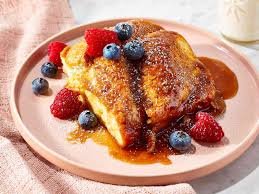
Oven Finish for Large Batches
- After pan-frying, place on a wire rack in a 200°F (93°C) oven for 5 minutes to crisp further.
Infused Syrups & Compotes
- Bourbon maple syrup: Simmer syrup with a splash of bourbon.
- Berry compote: Cook down mixed berries with lemon juice and sugar.
Conclusion
Now that you’ve looked into the art and science of crafting impeccable French toast with eggs, you possess not just a recipe but a culinary framework for innovation. This dish, rooted in simplicity yet boundless in its adaptability, invites both precision and creativity. Whether you adhere to the classic custard-soaked brioche or venture into avant-garde interpretations—infusing your egg mixture with espresso for depth or finishing with a flambéed rum glaze—the techniques you’ve acquired ensure consistently exceptional results.
French toast transcends mere breakfast fare; it’s a canvas for cultural fusion and personal expression. Imagine serving a deconstructed version with crème anglaise and caramelized figs for a brunch centerpiece or reinventing it as a savory appetizer with gruyère and thyme. The interplay of temperature control (a steadfast medium-low heat), optimal soak time (that critical 15-second window), and quality ingredients (think farm-fresh eggs and artisanal bread) transforms humble components into gastronomic artistry.
For those seeking perfection, remember: the hallmark of sublime French toast lies in its contrast—a crisp, caramelized exterior yielding to a luxuriously tender interior. Achieve this by allowing the cooked slices to rest briefly, letting residual heat gently set the custard. Pair with single-origin maple syrup or a housemade berry coulis to elevate the experience further.
As you embark on your French toast endeavors, document your experiments—adjusting cinnamon levels, testing alternative milks, or even aging bread sous vide for controlled dehydration. Share your creations, gather feedback, and refine. After all, mastery is iterative.
So, preheat your skillet, and let the alchemy begin. With each golden-brown slice, you’re not just making breakfast; you’re honing a craft. Bon appétit.

